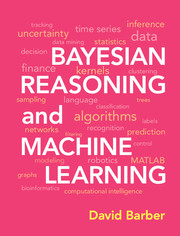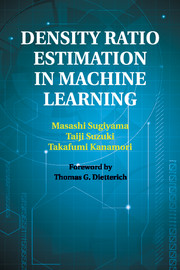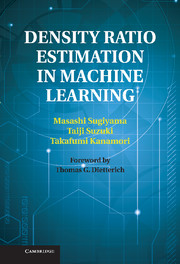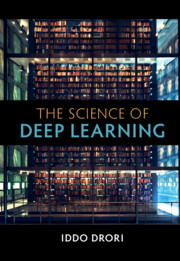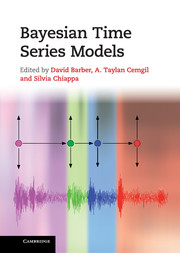Bayesian Reasoning and Machine Learning
Machine learning methods extract value from vast data sets quickly and with modest resources. They are established tools in a wide range of industrial applications, including search engines, DNA sequencing, stock market analysis, and robot locomotion, and their use is spreading rapidly. People who know the methods have their choice of rewarding jobs. This hands-on text opens these opportunities to computer science students with modest mathematical backgrounds. It is designed for final-year undergraduates and master's students with limited background in linear algebra and calculus. Comprehensive and coherent, it develops everything from basic reasoning to advanced techniques within the framework of graphical models. Students learn more than a menu of techniques, they develop analytical and problem-solving skills that equip them for the real world. Numerous examples and exercises, both computer based and theoretical, are included in every chapter. Resources for students and instructors, including a MATLAB toolbox, are available online.
- Consistent use of modelling encourages students to see the bigger picture while they develop hands-on experience
- Full downloadable MATLAB toolbox, including demos, equips students to build their own models
- Website includes figures from the book, LaTeX code for use in slides, and additional teaching material that enables instructors to easily set exercises and assignments
Reviews & endorsements
"With approachable text, examples, exercises, guidelines for teachers,
a MATLAB toolbox and an accompanying web site, Bayesian Reasoning and
Machine Learning by David Barber provides everything needed for your
machine learning course. Only students not included."
Jaakko Hollmén, Aalto University
"Barber has done a commendable job in presenting important concepts
in probabilistic modeling and probabilistic aspects of machine learning.
The chapters on graphical models form one of the clearest and most concise
presentations I have seen. The book has wide coverage of probabilistic
machine learning, including discrete graphical models, Markov decision
processes, latent variable models, Gaussian process, stochastic and deterministic
inference, among others. The material is excellent for advanced undergraduate
or introductory graduate course in graphical models, or probabilistic machine
learning. The exposition throughout the book uses numerous diagrams and
examples, and the book comes with an extensive software toolbox - these will
be immensely helpful for students and educators. It's also be a great resource
for self-study for people with background knowledge in basic probability and
linear algebra."
Arindam Banerjee, University of Minnesota
"I repeatedly get unsolicited comments from my students that the contents
of this book have been very valuable in developing their understanding
of machine learning. This book appeals to readers from many backgrounds,
and is driven by examples of machine learning in action. Despite
maintaining that level of accessibility, it does not avoid covering
areas that are of practical use but often harder to explain. Neither
does it shun a proper understanding of why the methods work; each
chapter is a pointer to the overall probabilistic framework upon which
these machine learning methods depend. My students praise this book
because it is both coherent and practical, and because it makes fewer
assumptions regarding the reader's statistical knowledge and confidence
than many books in the field."
Amos Storkey, University of Edinburgh
"This book is an exciting addition to the literature on machine learning
and graphical models. What makes it unique and interesting is that it
provides a unified treatment of machine learning and related fields
through graphical models, a framework of growing importance and
popularity. Another feature of this book lies in its smooth transition
from traditional artificial intelligence to modern machine learning. The
book is well-written and truly pleasant to read. I believe that it will
appeal to students and researchers with or without a solid mathematical
background."
Zheng-Hua Tan, Aalborg University
Product details
June 2012Adobe eBook Reader
9781139118729
0 pages
0kg
287 b/w illus. 1 table 260 exercises
This ISBN is for an eBook version which is distributed on our behalf by a third party.
Table of Contents
- Preface
- Part I. Inference in Probabilistic Models:
- 1. Probabilistic reasoning
- 2. Basic graph concepts
- 3. Belief networks
- 4. Graphical models
- 5. Efficient inference in trees
- 6. The junction tree algorithm
- 7. Making decisions
- Part II. Learning in Probabilistic Models:
- 8. Statistics for machine learning
- 9. Learning as inference
- 10. Naive Bayes
- 11. Learning with hidden variables
- 12. Bayesian model selection
- Part III. Machine Learning:
- 13. Machine learning concepts
- 14. Nearest neighbour classification
- 15. Unsupervised linear dimension reduction
- 16. Supervised linear dimension reduction
- 17. Linear models
- 18. Bayesian linear models
- 19. Gaussian processes
- 20. Mixture models
- 21. Latent linear models
- 22. Latent ability models
- Part IV. Dynamical Models:
- 23. Discrete-state Markov models
- 24. Continuous-state Markov models
- 25. Switching linear dynamical systems
- 26. Distributed computation
- Part V. Approximate Inference:
- 27. Sampling
- 28. Deterministic approximate inference
- Appendix. Background mathematics
- Bibliography
- Index.

